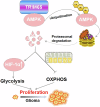TRIM65 regulates glucose metabolic reprogramming to promote glioma cell proliferation via ubiquitination and degradation of AMPK
- PMID: 40473847
- PMCID: PMC12141518
- DOI: 10.1038/s41698-025-00964-z
TRIM65 regulates glucose metabolic reprogramming to promote glioma cell proliferation via ubiquitination and degradation of AMPK
Abstract
Glioma is the most common primary malignant brain tumor with high mortality and poor prognosis. Aerobic glycolysis is crucial for the malignant behavior of glioma by promoting their growth. Tripartite motif containing 65 (TRIM65) as an E3 ubiquitin ligase has been implicated in tumor progression, but its role and regulatory mechanism on aerobic glycolysis in glioma remains unclear. Here, it was demonstrated that TRIM65 was highly expressed in human glioma tissues and associated with poor prognosis. Moreover, TRIM65 knockdown inhibited the glioma cells proliferation in vitro and in vivo. RNA sequencing and biological verifications were performed to elucidate a novel mechanism underlying TRIM65 silencing attenuated glycolysis and enhanced OXPHOX to suppress the growth of glioma cells. Subsequently, we found that TRIM65 interacted with AMPK, a metabolic sensor, and mediated its K48-linkage ubiquitination and degradation though proteasomal pathway, thereby regulating HIF-1α-induced glycolysis. Importantly, the inhibitory effect of TRIM65 silencing on glycolysis was abrogated by AMPK knockdown or HIF-1α overexpression, indicating glucose metabolic reprogramming by TRIM65 is dependent on AMPK and HIF-1α pathway. These results reveal a new role for TRIM65/AMPK/HIF-1α axis in glioma cell proliferation and aerobic glycolysis, suggesting that TRIM65 may be a potential therapeutic target for intervention of glioma.
© 2025. The Author(s).
Conflict of interest statement
Competing interests: The authors declare no competing interests.
Figures








Similar articles
-
TRPM7 silencing modulates glucose metabolic reprogramming to inhibit the growth of ovarian cancer by enhancing AMPK activation to promote HIF-1α degradation.J Exp Clin Cancer Res. 2022 Jan 31;41(1):44. doi: 10.1186/s13046-022-02252-1. J Exp Clin Cancer Res. 2022. PMID: 35101076 Free PMC article.
-
TRIM65 Promotes Cervical Cancer Through Selectively Degrading p53-Mediated Inhibition of Autophagy and Apoptosis.Front Oncol. 2022 Mar 24;12:853935. doi: 10.3389/fonc.2022.853935. eCollection 2022. Front Oncol. 2022. PMID: 35402260 Free PMC article.
-
Tripartite Motif-Containing Protein 65 Promotes Proliferation and Inhibits Ferroptosis in Prostate Cancer via Enhancing NKD Inhibitor of WNT Signaling Pathway 2 Ubiquitination.Rejuvenation Res. 2025 Jun;28(3):113-124. doi: 10.1089/rej.2024.0061. Epub 2024 Dec 23. Rejuvenation Res. 2025. PMID: 39714941
-
TRIM65 triggers β-catenin signaling via ubiquitylation of Axin1 to promote hepatocellular carcinoma.J Cell Sci. 2017 Sep 15;130(18):3108-3115. doi: 10.1242/jcs.206623. Epub 2017 Jul 28. J Cell Sci. 2017. PMID: 28754688
-
The E3 Ubiquitin Ligase TRIM65 Negatively Regulates Inflammasome Activation Through Promoting Ubiquitination of NLRP3.Front Immunol. 2021 Aug 26;12:741839. doi: 10.3389/fimmu.2021.741839. eCollection 2021. Front Immunol. 2021. PMID: 34512673 Free PMC article.
References
-
- Weller, M. et al. Glioma. Nat. Rev. Dis. Prim.10, 33 (2024). - PubMed
-
- Louis, D. N. et al. The 2016 World Health Organization classification of tumors of the central nervous system: a summary. Acta Neuropathol.131, 803–820 (2016). - PubMed
-
- Stupp, R. et al. Radiotherapy plus concomitant and adjuvant temozolomide for glioblastoma. N. Engl. J. Med.352, 987–996 (2005). - PubMed
-
- Hanahan, D. & Weinberg, R. A. Hallmarks of cancer: the next generation. Cell144, 646–674 (2011). - PubMed
Grants and funding
- 82303229/National Natural Science Foundation of China
- 82260173/National Natural Science Foundation of China
- 81472371/National Natural Science Foundation of China
- 82260626/National Natural Science Foundation of China
- 20232BAB216078/Jiangxi Provincial Natural Science Foundation
- 20212BDH81020/Jiangxi Provincial Natural Science Foundation
- 20224ACB206014/Jiangxi Provincial Natural Science Foundation
- 20224BAB216052/Jiangxi Provincial Natural Science Foundation
- 2023ZD001/Jiangxi Provincial Health Commission Science and Technology Plan Project
- 202310128/Jiangxi Provincial Health Commission Science and Technology Plan Project
- 2022A346/Jiangxi Provincial Traditional Chinese Medicine Science and Technology Plan Project
LinkOut - more resources
Full Text Sources

